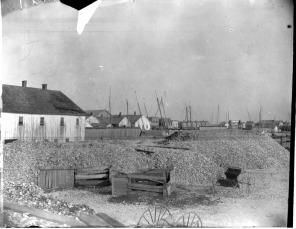The House of Moulton
This 6-room,1-bath mail order house located at 8409 58th Avenue was built in 1920 – 1921 by the Berwyn Heights Company.1 It was purchased by Catherine A. Moulton (1874-1938) and her daughters Monemia and Parthia, joint tenants, in February 1922.2 Prior to purchasing the home, Catherine lived in Dorchester County on Maryland’s Eastern Shore. She was married to Francis J. Moulton (1868-1909), who worked as an oysterman off Hooper’s Island in the Chesapeake Bay.3 They had 5 children: twin girls Monemia and Parthia born in 1901, then Howard (1903), Charles (1905) and Lilly (1909).4
Catherine, nee Fitzpatrick, was an immigrant. She came to America from Ireland with her family in April 1887 aboard the ocean liner City of Montreal.5 Francis, on the other hand, grew up in a prominent New England family. He was born in France to Charles Raymond and Lillie (Greenough) Moulton.6 His Moulton ancestors had first settled in Saalem, MA in the late 1600s, and their English forebears trace their lineage to Thomas Moulton who fought with William the Conqueror in the Battle of Hastings in 1066.7
Charles R. Moulton was a wealthy banker, and a son of Charles F. Moulton, a merchant from Troy, NY, who had accumulated a great fortune in the cotton trade. Charles Sr. was a personal friend of Louis Napoleon, and he and his family moved to Paris when Napoleon became Emperor of France in 1852.8 The Moultons owned several houses in and near Paris, including the Chateau de Petit Val, where Charles Jr. and his wife Lillie would reside after their marriage. Lillie was a famous soprano and an appreciated guest at the court of Louis Napoleon. She gave performances in Paris’ high society and counted among her friends such important composers as Liszt, Wager, Rossini, Gounod and Auber.9 After the fall of Napoleon III in 1870, the Moultons returned to the United States, where Charles died. In 1875, Lillie married the Danish diplomat, Johann de Hegermann-Lindencrone, whom she followed to Washington and a number of European capitals where he served. Her life in Paris and as a diplomats wife is chronicled in two books of letters she published in 1911 and 1913.10
Lillie’s children were raised with the help of nurses. After her return to America, they stayed with her family at Fay House in Cambridge, MA and went to school there.11 Considering the upbringing, it is a bit of a mystery how the Moulton scion Francis ended up working the oyster grounds of the Chesapeake Bay. But the leap is perhaps not as great as it might first appear.
In the late 1800s, the Chesapeake Bay was experiencing an oyster boom that drew men in search of profit from many places, in particular from New England. The once thriving New England oyster industry had gone into decline because its oyster beds had been depleted. But the Chesapeake seemed to have an inexhaustible supply. In the peak year of 1884, 15 million bushels of oysters were harvested in the Chesapeake, representing nearly half of the world’s supply.12 A reporter for Harper’s Magazine described the boom as “simply a mad scramble carried on in 700 boats manned by 5,600 daring and unscrupulous men.”13 The scramble pitted mostly local watermen, who “tonged” for oysters in the shallow waters of the river deltas, against outsiders, or “oyster pirates,” who “dredged” in deeper waters, but gradually encroached on the tongers’ territory. This resulted in numerous violent clashes and often death. The efforts of the Maryland Oyster Navy to restore order during the Chesapeake Oyster Wars were largely ineffective.14
All things considered, Francis’ illustrious ancestry did not have much practical significance in his adult life. He died in March 1909 at the age of 41 from inflammation of the kidneys and acute bronchitis,15 possibly the result of working in the icy waters of the Chesapeake during the winter oyster season. Catherine was left to raise their children. The year 1920 finds her living in Vienna, Dorchester County, where she was employed as a laborer, while her sons worked as farm hands.16 Her daughters Monemia and Parthia both attended Maryland State Normal School (Towson University).17 After graduating in 1920, the Misses Moulton first lived in Washington, D.C., where Monemia was a clerk in the Commerce Department,18 before moving to Berwyn Heights. The Berwyn Heights house was sold in August 1939, a year after Catherine died, to Arthur and Mabel Shank.19 Catherine and two of her children are buried at Fort Lincoln Cemetery.
1 Berwyn Heights Company Minute Book, Page 64
2 Deed, 4 February 1922, Berwyn Heights Company to Catherine A. Moulton, Monemia Moulton & Parthia Moulton, Prince George’s Land Records, Book 237, Page 357.
3 U.S. Census Record, 1900.
4 U.S. Census Record, 1910.
5 City of Montreal Passenger List, 19 April 1887.
7 Miller, Charles C., and Samuel A. Baxter, eds. “The History of Allen County, Ohio and Representative Citizens.,” Chicago: Richmond & Arnold, 1906. Page 805.
8 Miller and Baxter. Page 809.
9 Hegermann-Lindencrone, Lillie. “In the Courts of Memory, 1858-1875,” Garden City, NY: Garden City Publishing Co. 1911. Page vii.
10 Hegermann-Lindencrone, Lillie. “The Sunny Side of Diplomatic Life, 1875-1912.” New York: Harper’s & Bros. Publishers, 1913
11 U.S. Census record, 1880.
12 Wikipedia entry https://en.wikipedia.org/wiki/OysterWars, retrieved 10-14-2017.
13 Wennersten, John R. “The Oyster Wars of the Chesapeake Bay,” Tidewater Press, 1981. Page 55.
14 Wennersten
16 U.S. Census record, 1920.
17Maryland State Normal School. Book of the Senior Class, Vol. I. Towson MD, 1919. Page 60.
18 D.C. City Directory, 1922.
19 Deed, 10 August 1939, Prince George’s Land Records, Book 538, Page 67.


